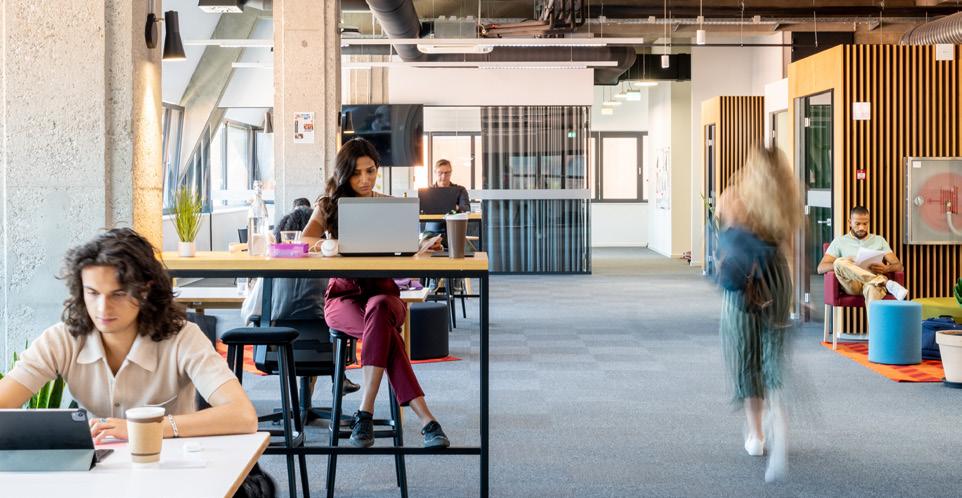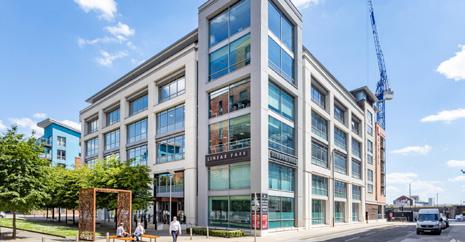Office & Business Space Insights
Edition 1 • Autumn 2024

Edition 1 • Autumn 2024
One of the major outcomes of the last three years has been a global shift towards disrupted working models, and the discussion where the tangible, physical spaces of work should be.
However, beneath the surface lies a complex psychological tapestry that influences and shapes the current workplace experience – these are the less visible, but equally significant, psychological dimensions of ‘hybrid’ working.
Traditionally, the workplace has been a space where all team members could benefit from the proximity to co-workers, whether senior or junior to guide, mentor and share experiences, that help inform, educate and foster culture.
The right office environment is vital for the learning and development of younger colleagues particularly those entering the workforce after school, college or university because it provides experiences which cannot be replicated by working remotely.
Younger colleagues benefit immensely from direct interaction with experienced colleagues to watch and learn how they deal with difficult situations or handle clients as well as having

an immediate opportunity to ask questions and receive feedback, fostering a strong learning dynamic that is not included in any formal training programmes.
The workplace gives everyone the opportunity to learn more about the company’s culture and values. This is crucial for professional growth and boosts confidence, contributions and empowerment as staff take on more significant challenges and responsibilities.
The importance of this should not be underestimated. Gallup’s State of the Global Workplace 2024 report which has just been released highlights that many employees feel like they’re engaged in an uphill struggle. 41% are feeling “a lot of stress” and globally, one in five employees in the report say they

experience daily loneliness. This percentage is higher for employees under 35 and lower for those aged over 35. Fully remote employees report significantly higher levels of loneliness (25%) than those who work fully on-site (16%).
The report highlights that wellbeing among younger employees dropped in 2023, and it says employers should address mental health support to help colleagues thrive in life and engage at work to build productive, highperforming teams.
Flexibility is now the new currency of the workforce. As the world evolves, so do the priorities of its workforce with many employees willing to trade off other benefits for a more adaptable work-life balance.
The psychological impact of this shift is quite profound, employees who exercise greater control over their schedules often report higher job satisfaction and reduced stress levels which, in time, leads to an improved overall wellbeing.
Hybrid working models have the potential to foster inclusivity by accommodating diverse needs and preferences. They offer a solution for those re-entering the workforce, seeking the social interaction and structure that office life provides, while also catering for those who prefer the quiet focus of home working.



A new ‘social contract’ for the workplace seems to be unfolding, being driven by employees’ demand for flexible working and companies’ operational needs.
This trend has been evident for nearly a decade, with the pandemic acting as an accelerant.
The 2024 KPMG CEO Outlook Survey reveals that the return-to-office debate remains challenging.
CEOs are increasingly firm about returning to pre-pandemic work practices, with 83 percent expecting a full return to the office within the next three years, up from 64 percent in 2023.
This shift has significant implications for office agents and investors, likely driving four key trends in the NW office market:

Hybrid work models are gaining traction, and in light of current economic challenges, business leaders are reassessing their workplace needs.
In the NW, many are choosing smaller, high-value locations and adopting more creative workplace designs. These designs blend formal meeting areas with informal collaboration zones, quiet workspaces, and lifestyle facilities such as bike parks, showers, restaurants, and zen/massage areas. Offices are becoming increasingly people-centric.
Previously, traditional Grade A buildings were the pinnacle of the office market. Today, “prime” properties go beyond offering the highest quality specifications. They address two major occupier drivers: the growing need for amenities and the strictest sustainability protocols to meet ESG ambitions.
Investing in creating ‘prime workplaces’ yields measurable benefits, including faster letting of vacant properties and achieving rental premiums.
Properties that fail to meet net zero goals or the demands of today’s discerning occupiers will struggle. In the NW, this has resulted in a two-tier market, with an oversupply of lowerquality assets in secondary locations and a scarcity of prime office stock in desirable postcodes.
The demand for ‘fitted offices’ (ready-to-use suites) in the NW is on the rise. In Manchester, there was nearly a 20% take-up in Q1 2024, compared to an 11% annual take-up in 2022. Occupiers are drawn to these spaces due to the lack of upfront capital expenses, reduced delivery risks, and the appeal of flexible leasing arrangements, offering a ‘plug-and-play’ option. For landlords, fitted offices attract a broader tenant demographic and command average rental premiums around 20% higher than traditional leases.
Repurposing secondary and problematic assets has become easier due to legislative changes that allow office buildings, regardless of size, to be converted into residential accommodation without full planning permission (in areas not covered by Article 4 directives).
This change addresses two significant issues: high void rates in poor-quality secondary office spaces and a shortage of housing for local residents.
Other potential alternative uses include hotels, life sciences, and educational facilities.
Conclusion: Firms seem to be downsizing and moving to better quality offices as they adjust to increased remote working. Prime office vacancies in the NW are expected to remain low and secondary offices will suffer as the tenants of those buildings move to the newer stock.



